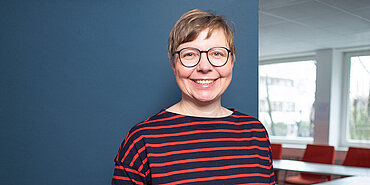Anyone involved in US-German exchange has probably already noticed that a stronger transatlantic wind is blowing through politics and practice than was the case just a few years ago. On behalf of the Federal Ministry for Family Affairs, Senior Citizens, Women and Youth, IJAB began its work on the topic of transatlantic exchanges about one year ago. It was now time to present the results to a broad audience and promote dialog between politicians and practitioners. This was the impetus behind the symposium “Youth Exchange with the USA,” which took place online on November 3, 2022.
Insights from politics...
It was therefore important to get insights from different perspectives. With his keynote speech, Nathan Cooper from the US Embassy in Berlin kicked off the discussion and talked about the impetus and prospects for youth exchanges between Germany and the US from an American perspective. Did you know that over 1,000 employees work in the diplomatic missions of the U.S. Department of State in Germany?
He also gave the audience an insight into why the US government works to promote exchanges and which issues are now most relevant in this context. Sustainability and diversity in youth exchanges as well as the opportunities of digital exchange and networking are currently high on the agenda and determine the direction of future exchange programs, which will be earmarked for even more funding in the long term.
Dr Fabrizio Micalizzi from the German Federal Foreign Office also underlined the importance of US-German exchanges and the desire to make exchanges between the two countries accessible and attractive to new and broader target groups. He said new exchange narratives were required to address young people's interest in each other. Practical experience shows how this can be done.
...and everyday practice
And it is practical experience, in turn, that confirms what IJAB also discovered when it appraised data from the different countries. Between Germany and the US, imbalances exist in terms of their political structures. Formal education (school education, vocational education and training, university/college education) and non-formal education (after-school programs) are separate areas in Germany, whereas in the US there is no such segmentation. This can hamper the process of finding partners and funding projects. In other words, it sometimes takes imagination and also willingness to view one's own field of work more broadly in order to develop new formats. This is especially true of non-formal youth work, which has no exact equivalent in the US. At the same time, everyone agrees that this fact alone holds huge potential for exchanges and critical reflection about one's own work.
- Watch the panel discussion on German-American youth exchanges on Youtube with Nathan Cooper, Deputy Cultural Affairs Attaché at the US Embassy Berlin, Annette Fuchs, Head of Kolping Youth Community Services, Katja Greeson, Transatlantic Program Officer at the Aspen Institute, Dr Fabrizio Micalizzi, Personal Assistant to the Coordinator for Transatlantic Cooperation, Michael Link, Member of the German Bundestag in the Federal Foreign Office, and Knut Möller, Executive Director of YFU – Deutsches Youth For Understanding Komitee e.V. and member of the Round Table USA.
It all comes down to funding
What hangs over all of this is the question of funding. Transatlantic exchanges involve high travel and accommodation costs, which are not or only partially covered by many funding rates. Moreover, a large number of funding programs in Germany are often linked to specific educational areas or project goals. The funding program “Sonderprogramm USA” of the Federal Ministry for Family Affairs, Senior Citizens, Women and Youth (BMFSFJ) offers greater flexibility in this respect, because it is not integrated into a specific program but enables funding organizations to establish partnerships freely. Lara Schuster from the BMFSFJ talked about what the special program can do.
Spätestens für Gruppen aus den USA, die nach Deutschland kommen möchten, wird es dann trotzdem kompliziert. Auf amerikanischer Seite fehlen im Vergleich zur deutschen Förderlandschaft institutionalisierte Programme, die die Finanzierung von Austauschmaßnahmen ermöglichen.
To sum it all up …
The high level of interest in the symposium underlined the importance German youth organizations attach to exchanges with the USA. Practical workshops also highlighted the fact that transatlantic youth exchanges actually work, that they have a tremendous impact, and that they forge friendships across the Atlantic.
Over the course of the event, the desire for more networking activities, greater visibility for existing structures and support services as well as more information on funding opportunities and new formats became apparent. IJAB’s task will be to build on this and address existing interest in 2023 and beyond.



![[Translate to Englisch:] Nahaufnahme der US-amerikanischen Flagge](/fileadmin/_processed_/7/3/csm_2022-01-27-lucas-sankey-gdQ_az6CSPo-unsplash_fab661a9d0.jpg)


